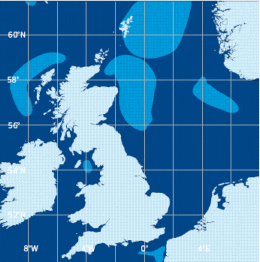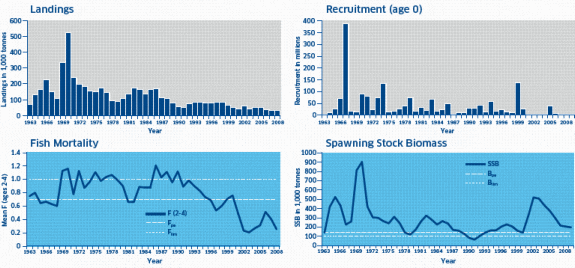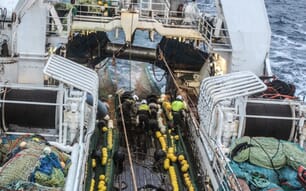Introduction

Biology
In the North Sea, haddock occur mainly in the northern and central areas, but can be found as far south as the humber estuary. At the beginning of the 20th century they were also abundant in the southern North Sea.

Virtually all three year old fish are mature and in some years over 80 per cent of two year olds may be mature. A three year old female of average size is able to produce around 300,000 eggs in a season. haddock release their eggs over several weeks. Spawning runs from february until early May and occurs in almost any area of the North Sea from the Scottish coast to the Norwegian deeps. There are differences in the length of the spawning season, associated with the size and age of the local population, with age two fish spawning later. The spawning fish on inshore grounds are usually smaller and younger fish than those found in offshore areas. As a result the spawning period of inshore fish can be around half of the time of that found offshore.

In the northern North Sea most of the larvae do not travel far from the spawning grounds. Some larvae from the west coast spawning grounds can be transported to the North Sea, which they enter through the fair Isle/Shetland Gap or to the north east of Shetland. young haddock spend the first few months of life in the upper water layers before moving to the seabed.
Tag recapture studies suggest that whilst adult shoals spread out after spawning many do not inter-mix with haddock from distant spawning areas. results from early genetic studies on haddock have suggested there could be different populations within the North Sea. however, whilst there are regional differences in maturity between these proposed populations, tagging, parasite and more recent genetic studies have questioned the proposed differences.
The diet of haddock varies with the size of the fish, the time of year, and with the area. In the winter months haddock of all sizes feed mainly on worms, small molluscs, sea urchins and brittle stars. In the spring and summer fish prey are important, particularly for the larger haddock. The type of fish prey reflects the local availability, with Norway pout being the most common fish eaten in the more northerly areas, whereas sandeels are more important in the central North Sea.
ICES Advice on Management

Summary
- Fishing mortality is estimated to be well below Fpa and also lower than FhCr (0.3)
- Spawning stock biomass is estimated to be above Bpa
- Spawning stock biomass is declining due to recent poor recruitment
- Discarding of haddock is decreasing in the fishery
Precautionary approach reference points
For haddock in the North Sea, ICES has proposed that the precautionary level for spawning stock biomass (Bpa) be set at 140,000 tonnes, and that the precautionary level for fishing mortality (Fpa) be set at 0.7. The limit reference point for spawning stock biomass (Blim) is 100,000 tonnes, and limit reference point for fishing mortality (Flim) is 1.00.
State of stock
Based on the most recent estimate of spawning stock biomass (in 2009) and fishing mortality (in 2008), ICES classifies the stock as having full reproductive capacity and being harvested sustainably. SSB in 2009 is estimated to be above Bpa, although SSB has been declining since 2002. Fishing mortality in 2008 is estimated to be below Fpa, and below the target FhCr (0.3) specified in the EU–Norway management plan. Recruitment is characterized by occasional large yield-classes, the last of which was the strong 1999 year class. Apart from the 2005 year class which is about average, recent recruitment has been poor.
Management advice
In 1999 the EU and Norway agreed to implement a long-term management plan for the haddock stock, which is consistent with the precautionary approach and which is intended to constrain harvesting within safe biological limits (SSB > Blim) and is designed to provide for sustainable fisheries and high potential yield. A revised management plan was implemented in January 2009. The main elements of the plan are a target F of 0.3 with a limit of 15 per cent change in TAC provided SSB is maintained above 140,000 tonnes. If SSB is between 140,000 tonnes and 100,000 tonnes, F is reduced in line with SSB to reach F = 0.1 at SSB = 100,000 tonnes. If SSB is at 100,000 tonnes or below, F is 0.1. Interannual quota flexibility is permitted, with a maximum of 10 per cent transfer of quota between years.
ICES has evaluated this EU–Norway management plan and concluded that the target FHCR = 0.3 with TAC constraint ±15 per cent leads on average to a <5 per cent risk of B lim within the next 20 years. Increasing the target FHCR increases the risk. Although the management plan has not been fully tested (e.g. at lower fishing mortalities), ICES concludes that the management plan can provisionally be accepted as precautionary and be used as the basis for advice.
Interannual quota flexibility has also been evaluated and it is concluded that this has no significant impact on sustainability.
ICES advises that the exploitation of North Sea and IIIa haddock be based on the agreed management plan. This would imply landings of 38,000 tonnes in 2010, which would lead to an SSB of 185,000 tonnes in 2011. The ±15 per cent interannual TAC variability has been invoked in this case, decreasing the 2010 landings compared to the 2009 quota.
Discards of haddock in 2006 and 2007 were fairly substantial due to the moderately sized 2005 year class entering the fishery, but were considerably lower in 2008, possibly due to the growth of the 2005 year class past the minimum landing size. further improvements to gear selectivity would reduce the amount discarded by allowing the release of undersized fish. This would not only be beneficial for haddock stocks, but also juveniles of other species that occur in mixed fisheries where haddock are caught.
Due to the 2006 – 2008 year classes being weak, even at the current low level of fishing mortality the spawning stock biomass is likely to continue to decline from 2010 onwards unless a moderate to strong year class appears. early indications from surveys suggest that the 2009 year class will be rather better, although it is too early to determine the extent to which this will contribute to the fishable stock.
Management action
At the December 2009 Council of Ministers meeting in Brussels, the provisional eu Total Allowable Catch for North Sea (IIa & Iv) haddock was set at 26,965 tonnes, with the uk quota for 2010 at 22,698 tonnes. The presented TAC and quota are provisional at time of going to press and are subject to change.
May 2010

